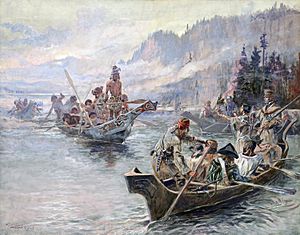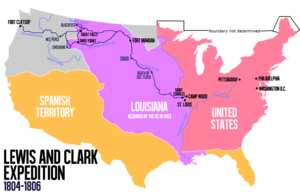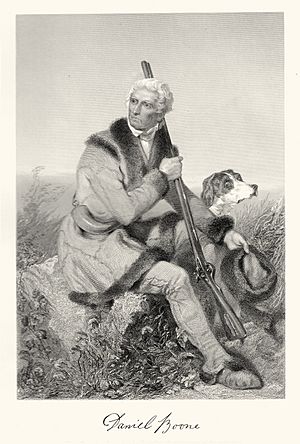John Shields (explorer) facts for kids
John Shields (born around 1769, died 1809) was an important member of the famous Lewis and Clark Expedition. He was about 35 years old, making him one of the oldest members of the team. John was a skilled hunter, blacksmith, and gunsmith. He traveled with Captain Meriwether Lewis, Second Lieutenant William Clark, and the Native American guide Sacagawea. Their amazing journey took them all the way to the Oregon Coast, where they built Fort Clatsop. After the expedition, John Shields even went hunting and trapping with the legendary American pioneer Daniel Boone.
Contents
Early Life and Family
John Shields was born around 1769 in Virginia's Shenandoah Valley. His family later moved to what is now Sevier County, Tennessee, around 1784. There, John and his brothers helped build Shields Fort. This fort protected their family from dangers in the wilderness. It was located near where the Dollywood theme park is today in Pigeon Forge, Tennessee.
Around 1790, John Shields married Nancy White. They had a daughter named Martha Jennette.
Joining the Lewis & Clark Expedition

John Shields joined the Lewis and Clark Expedition as a private on October 19, 1803. He stayed with the expedition until October 10, 1806. Even though the leaders usually wanted unmarried men, they chose Shields because of his valuable skills. He was a talented gunsmith, blacksmith, hunter, and scout. These skills were very important for the success of the journey.
In December 1803, the expedition members started building their winter camp, called Camp Dubois. It was located near the Mississippi River in what is now Illinois. They stayed there until May 14, 1804. Then, they began their long journey up the Missouri River, which is the longest river in North America.
John Shields' Skills and Discoveries
John Shields' skills were often mentioned in the journals kept by Captain Lewis, Lieutenant Clark, and Sergeant Ordway.
As a Blacksmith and Gunsmith
Shields was very important for repairing tools and weapons.
- In February 1805, Captain Lewis wrote that the blacksmiths, including Shields, were a "happy resource." They traded their work for corn from the Native Americans. The Native Americans loved the sheet iron they used, which they turned into arrow-points and tools.
- In July 1806, Lieutenant Clark noted that Shields fixed two rifles that had burst near the muzzle. He cut them shorter, and they still shot "tolerable well."
As a Hunter and Scout
Shields was also an excellent hunter, providing food for the expedition.
- In June 1806, Lieutenant Clark wrote that all the hunters returned with deer, but Shields brought in two!
- In August 1804, Sergeant Ordway recorded that Shields went out and killed a deer.
- In February 1805, Shields killed two deer and three goats for the group to eat.
Discovering New Animals
John Shields made an important discovery during the expedition.
- In September 1804, Sergeant Ordway wrote about Shields killing a "verry large white rabbit or haire." It was "as big as a Ureopian hare" and mostly white. This was the first description of the white-tailed jackrabbit, an animal previously unknown to science. Because of John Shields' discovery, this animal was later named a Jack rabbit.
Life After the Expedition
After returning from the Lewis & Clark Expedition, John Shields continued his adventurous life. He hunted and trapped with the famous American pioneer Daniel Boone in St. Charles County, Missouri. Daniel Boone had moved to Missouri in 1799, and the Lewis and Clark Expedition had passed near his home.
Later, Shields moved to Harrison County, Indiana. There, he hunted and trapped with Squire Boone, Daniel Boone's brother.
Captain Meriwether Lewis recognized Shields' great contributions. In January 1807, Lewis wrote to the US Secretary of War, Henry Dearborn. He said that Shields' "skill and ingenuity" in repairing guns and equipment were "peculiarly useful." Lewis believed Shields deserved extra pay for his work as an "artificer" (a skilled craftsman).
In June 1807, Shields settled in Indiana. He was appointed captain of the Clark County militia in July 1807. John Shields passed away in December 1809 in Harrison County, Indiana. He is buried at the Little Flock Baptist Cemetery.
To honor his memory, the Shields River, a tributary of the Yellowstone River in Montana, was named after him. A historical marker also stands near the Harrison County Courthouse in Corydon, Indiana, remembering his role in the Lewis and Clark Expedition.
Gravesite
John Shields' headstone is located at the Little Flock Baptist Cemetery in Elizabeth, Harrison County, Indiana. The inscription on his headstone states that he was a private in the U.S. Army and a member of the Lewis and Clark Expedition. It also highlights his important duties as a gunsmith, blacksmith, hunter, scout, and mechanic.



